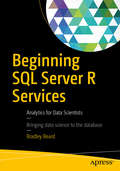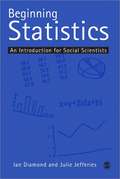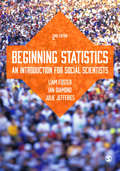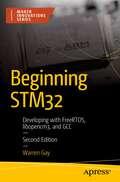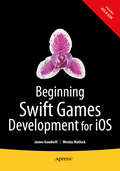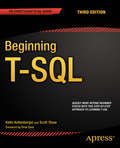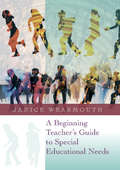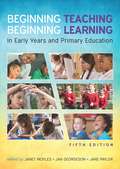- Table View
- List View
Beginning SQL Server R Services: Analytics for Data Scientists
by Bradley BeardLearn how to develop powerful data analytics applications quickly for SQL Server database administrators and developers. Organizations will be able to sift data and derive the business intelligence needed to drive business decisions and profit. The addition of R to SQL Server 2016 places a powerful analytical processor into an environment most developers are already comfortable with – Visual Studio. This book walks even the newest of users through the creation process of a powerful R-language tool set for use in analyzing and reporting on your data.As a SQL Server database administrator or developer, it is sometimes difficult to stay on the bleeding edge of technology. Microsoft’s addition of R to SQL Server 2016 is sure to be a game-changer, and the language will certainly become an integral part of future releases. R is in fact widely used today in statistical and related applications, and its use is only growing. Beginning SQL Server R Services helps you jump on board this important trend by providing good examples with detailed explanations of the WHY and not just the HOW.Walks you through setup and installation of SQL Server R Services.Explains the basics of working with R Tools for Visual Studio.Provides a road map to successfully creating custom R code.What You Will LearnDiscover R’s role in the SQL Server 2016 hierarchy.Manage the components needed to run SQL Server R Services code.Run R-language analytics and queries inside the database.Create analytic solutions that run across multiple datasets.Gain in-depth knowledge of the R language itself.Implement custom SQL Server R Services solutions.Who This Book Is ForAny level of database administrator or developer, but specifically it's for those developers with the need to develop powerful data analytics applications quickly. Seasoned R developers will appreciate the book for its robust learning pattern, using visual aids in combination with properties explanations and scenarios. Beginning SQL Server R Services is the perfect “new hire” gift for new database developers in any organization.
Beginning SQL Server Reporting Services
by Kathi KellenbergerLearn SQL Server Reporting Services and become current with the 2016 edition. Develop interactive, dynamic reports that combine graphs, charts, and tabular data into attractive dashboards and reports to delight business analysts and other users of corporate data. Deliver mobile reports to anywhere and any device. Build vital knowledge of Reporting Services at a time when Microsoft's dominance in business intelligence is on the rise. Beginning SQL Server Reporting Services turns novices into skilled report developers. The book begins by explaining how to set up the development environment. It then walks you through creating your first reports using the built-in wizard. After showing what is possible, the book breaks down and explains the skills needed to create reports from scratch. And not just reports! But also dashboards with charts, graphs, and maps. Each chapter builds on knowledge gained in the previous chapters with step-by-step tutorials. Beginning SQL Server Reporting Services boosts your skills and provides you additional career options. Don't be without those options. Grab and read this book today. Build reports with and without the built-in wizard. Build interactive features such as drill-through reports. Build dashboards full of charts, graphs, and maps. Build mobile reports. What You Will LearnSet up your development environment.Organized projects and share components among reports.Create report using a wizard.Create reports from scratch, including grouping levels, parameters, and drill through features.Build interactive dashboard with graphs, charts, and maps.Deploy and manage reports for use by others in the business. Who This Book Is ForDatabase professionals of all experience levels who have some experience in databases and want to make the leap into business intelligence reporting. The book is an excellent choice for those needing to add Reporting Services to their current list of skills, or who are looking for a skill set that is in demand for in order to break into IT.
Beginning Statistics: An Introduction for Social Scientists (1st edition)
by Ian Diamond Julie JefferiesWith an emphasis on description, examples, graphs and displays rather than statistical formulae, this book is the ideal introductory guide for students across the social sciences. It shows how all students can understand the basic ideas of statistics at a level appropriate with being a good social scientist. The authors explain the right ways to present data, how to describe a set of data using summary statistics and how to infer what is going on in a population when all you have to go on is the sample. The book uses small data sets to help students understand the basic principles, and no mathematics or statistical background is assumed.
Beginning Statistics: an introduction for social scientists (1st edition) (PDF)
by Ian Diamond Julie JefferiesThe clarity, simplicity and use of many practical examples makes this book very useful, primarily for under- and postgraduate students' - Journal of Biosocial Science With an emphasis on description, examples, graphs and displays rather than statistical formulae, this book is the ideal introductory guide for students across the social sciences. It shows how all students can understand the basic ideas of statistics at a level appropriate with being a good social scientist. The authors explain the right ways to present data, how to describe a set of data using summary statistics and how to infer what is going on in a population when all you have to go on is the sample. The book uses small data sets to help students understand the basic principles, and no mathematics or statistical background is assumed.
Beginning Statistics: An Introduction for Social Scientists
by Liam Foster Ian Diamond Julie BantonIn the Second Edition of this bestselling textbook, the authors use real-world examples to introduce basic principles in statistics with no prior knowledge or experience assumed. With an emphasis on describing concepts, showing through example and illustrating points with graphs and displays, this book will provide readers with a step-by-step introduction to using statistics. Chapters address the following questions: Why bother learning statistics in the first place and are they relevant to real life? How do I make sensible tables and informative graphs? What are descriptive and inferential statistics and how are they used? What are regression and correlation anyway?
Beginning Statistics: An Introduction for Social Scientists
by Liam Foster Ian Diamond Julie BantonIn the Second Edition of this bestselling textbook, the authors use real-world examples to introduce basic principles in statistics with no prior knowledge or experience assumed. With an emphasis on describing concepts, showing through example and illustrating points with graphs and displays, this book will provide readers with a step-by-step introduction to using statistics. Chapters address the following questions: Why bother learning statistics in the first place and are they relevant to real life? How do I make sensible tables and informative graphs? What are descriptive and inferential statistics and how are they used? What are regression and correlation anyway?
Beginning STM32: Developing with FreeRTOS, libopencm3 and GCC
by Warren GayUsing FreeRTOS and libopencm3 instead of the Arduino software environment, this book will help you develop multi-tasking applications that go beyond Arduino norms. In addition to the usual peripherals found in the typical Arduino device, the STM32 device includes a USB controller, RTC (Real Time Clock), DMA (Direct Memory Access controller), CAN bus and more. Each chapter contains clear explanations of the STM32 hardware capabilities to help get you started with the device, including GPIO and several other ST Microelectronics peripherals like USB and CAN bus controller. You’ll learn how to download and set up the libopencm3 + FreeRTOS development environment, using GCC. With everything set up, you’ll leverage FreeRTOS to create tasks, queues, and mutexes. You’ll also learn to work with the I2C bus to add GPIO using the PCF8574 chip. And how to create PWM output for RC control using hardware timers.You'll be introduced to new concepts that are necessary to master the STM32, such as how to extend code with GCC overlays using an external Winbond W25Q32 flash chip. Your knowledge is tested at the end of each chapter with exercises. Upon completing this book, you’ll be ready to work with any of the devices in the STM32 family. Beginning STM32 provides the professional, student, or hobbyist a way to learn about ARM without costing an arm!What You'll Learn Initialize and use the libopencm3 drivers and handle interruptsUse DMA to drive a SPI based OLED displaying an analog meterRead PWM from an RC control using hardware timersWho This Book Is ForExperienced embedded engineers, students, hobbyists and makers wishing to explore the ARM architecture, going beyond Arduino limits.
Beginning STM32: Developing with FreeRTOS, libopencm3, and GCC (Maker Innovations Series)
by Warren GaySee how using FreeRTOS and libopencm3 instead of the Arduino software environment will help you develop multi-tasking applications that go beyond Arduino norms. This updated version includes expanded coverage of software setup for Windows 10 and 11, additional TM32 hardware capabilities, including clear explanations of "totem pole outputs" versus "open drain outputs," and a new section on project showcasing an interrupt-driven approach for processing USART data.Each chapter contains clear explanations of the STM32 hardware capabilities to help get you started with the device, including GPIO and several other ST Microelectronics peripherals like USB and CAN bus controller. You’ll learn how to download and set up the libopencm3 + FreeRTOS development environment, using GCC. With everything set up, you’ll leverage FreeRTOS to create tasks, queues, and mutexes. You’ll also learn to work with the I2C bus to add GPIO using the PCF8574 chip. And how to create PWM output for RC control using hardware timers.You'll be introduced to new concepts that are necessary to master the STM32, such as how to extend code with GCC overlays using an external Winbond W25Q32 flash chip. Your knowledge is tested at the end of each chapter with exercises. Upon completing this book, you’ll be ready to work with any of the devices in the STM32 family. Beginning STM32, Second Edition provides the professional, student, or hobbyist a way to learn about ARM without costing an arm!What You'll Learn Initialize and use the libopencm3 drivers and handle interruptsUse DMA to drive a SPI based OLED displaying an analog meterRead PWM from an RC control using hardware timersUnderstand STM32 capabilities, including USB controller, RTC, DMA, CAN bus, and more Who This Book Is ForExperienced embedded engineers, students, hobbyists and makers wishing to explore the ARM architecture, going beyond Arduino limits.
Beginning SUSE Linux: From Novice to Professional
by Keir ThomasReaders of all levels stand to benefit from this book's coverage of SUSE's ability to play MP3s and DVDs, burn CDs, perform office tasks and data backups, and offer a secure operating system environment. Whether it is a reader evaluating SUSE for deployment in a corporate environment, or a student interested in foregoing expensive licensing arrangements, this book serves as an invaluable guide to the Linux platform. Having solidified its position as Europe's most popular variant SUSE Linux continues to grow in popularity within the U.S. market. SUSE is an increasingly viable alternative to the Windows platform on both the desktop and server level.
Beginning SVG: A Practical Introduction to SVG using Real-World Examples
by Alex LibbyDevelop SVG functionality for use within websites quickly and natively, using basic tools such as HTML and CSS. This book is a project-oriented guide to creating and manipulating scalable vector graphics in the browser for websites or online applications, using little more than a text editor or free software, and the power of JavaScript. You'll use a starting toolset to incorporate into your existing workflow, develop future projects, and reduce any dependency on graphics applications for simple projects. This book is an excellent resource for getting acquainted with creating and manipulating SVG content. We live in an age where speed and simplicity are of the essence. Beginning SVG provides a perfect alternative when creating web-based projects that challenges the norm and encourages you to expand your resources and not resort to what “everyone else uses” (such as Illustrator). You'll discover that there is indeed a different way to achieve the same result. Stop thinking you must always resort to using graphics packages; there is always another way!What You'll LearnCreate powerful, optimized content that can be quickly and easily manipulated within the browserGet up to speed with SVG quickly, with minimal effort and maximum resultsSee how easy it is to apply SVG content and effects, without the need for lots of additional tools.Who This Book Is For Website developers and agile development teams who are keen to learn how to add and manipulate SVG quickly.
Beginning Swift: Master the fundamentals of programming in Swift 4
by Rob Kerr Kare MorstolSwift greatly simplifies the process of developing applications for Apple devices. This book provides you with the essential skills to help you get started with developing applications using Swift. Key Features Teaches you how to correctly structure and architect software using Swift Uses real-world examples to connect the theory to a professional setting Imparts expertise in the core Swift standard library Book Description Take your first foray into programming for Apple devices with Swift.Swift is fundamentally different from Objective-C, as it is a protocol-oriented language. While you can still write normal object-oriented code in Swift, it requires a new way of thinking to take advantage of its powerful features and a solid understanding of the basics to become productive. What you will learn Explore the fundamental Swift programming concepts, language structure, and the Swift programming syntax Learn how Swift compares to other computer languages and how to transform your thinking to leverage new concepts such as optionals and protocols Master how to use key language elements, such as strings and collections Grasp how Swift supports modern application development using advanced features, such as built-in Unicode support and higher-order functions Who this book is for If you are seeking fundamental Swift programming skills, in preparation for learning to develop native applications for iOS or macOS, this book is the best for you. You don't need to have any prior Swift knowledge; however, object-oriented programming experience is desired.
Beginning Swift Games Development for iOS: Develop 2D and 3D games Using Apple's SceneKit and SpriteKit
by James Goodwill Wesley MatlockLearn the fundamental elements of the new Swift 3 programming language as applied to game development for new iOS 10.In Part 1 of this book, you'll start with a basic 2D game idea and build the game throughout the book introducing each SpriteKit topic as you add new functionality to the game. By the end of the book, you'll have experience with all the important SpriteKit topics and have a fully functional game as a result. In Part 2, you'll learn 3D game development using Apple's SceneKit framework and the Swift programming language, following the same pattern used for Part 1. Game apps are one of the most popular categories in the Apple iTunes App Store. In response, James Goodwill and Wesley Matlock bring you Beginning Swift Games Development for iOS, Third Edition an update to their best-selling work. After reading and using this book, you'll have the skills and the code to build your first 2D and then 3D game app that you can run on any iOS-enabled device.What you’ll learn Discover what’s in the new Swift 3 programming language Apply Swift 3 to iOS 10 and 9 game development Build a 2D game app using SpriteKit and Swift Build a 3D game from 2D using SceneKit and Swift Who this book is foriOS app developers new to Swift or for those thinking of trying iOS game app development for the very first time.
Beginning Swift Games Development for iOS: Updated For Swift 3
by James Goodwill Wesley MatlockGame apps are one of the most popular categories in the Apple iTunes App Store. Well, the introduction of the new Swift programming language will make game development even more appealing and easier to existing and future iOS app developers. In response, James Goodwill, Wesley Matlock and Apress introduce you to this book, Beginning Swift Games Development for iOS. In this book, you'll learn the fundamental elements of the new Swift language as applied to game development for iOS. In part 1, you'll start with a basic 2D game idea and build the game throughout the book introducing each SpriteKit topic as we add new functionality to the game. By the end of the book, you'll have experience with all the important SpriteKit topics and have a fully functional game as a result. In part 2 of this book, you'll learn 3D game development using Apple's SceneKit framework and the Swift programming language. And, you'll follow the same pattern we used for part 1. After reading and using this book, you'll have the skills and the code to build your first 2D and then 3D game app that you can run on any iOS enabled device and perhaps sell in the Apple iTunes App Store.
Beginning Swift Programming
by Wei-Meng LeeEnter the Swift future of iOS and OS X programming Beginning Swift Programming is your ideal starting point for creating Mac, iPhone, and iPad apps using Apple's new Swift programming language. Written by an experienced Apple developer and trainer, this comprehensive guide explains everything you need to know to jumpstart the creation of your app idea. Coverage includes data types, strings and characters, operators and functions, arrays and dictionaries, control flow, and looping, with expert guidance on classes, objects, class inheritance, closures, protocols, and generics. This succinct — yet complete — overview provides a detailed introduction to the core features of Swift. Apple developed Swift to address the limitations of Objective-C, and add features found in more complex languages like Python. The results is simpler, cleaner, more expressive code with automatic memory management, functional programming patterns, and more, including built-in features that make Swift apps faster, scalable, and more secure. This book explains it all, helping developers master Apple's new language. Become fluent with syntax that's easier to read and maintain Understand inferred types for cleaner, less mistake-prone code Learn the key features that make Swift more expressive than Objective-C Learn the new optional types in Swift that make your code more resilient Understand the key design patterns in iOS and Mac OS programming using protocols and delegates Learn how to use generics to create highly reusable code Learn the new access controls mechanism in Swift Get up to speed quickly to remain relevant and ahead of the curve.
Beginning Swift Programming
by Wei-Meng LeeEnter the Swift future of iOS and OS X programming Beginning Swift Programming is your ideal starting point for creating Mac, iPhone, and iPad apps using Apple's new Swift programming language. Written by an experienced Apple developer and trainer, this comprehensive guide explains everything you need to know to jumpstart the creation of your app idea. Coverage includes data types, strings and characters, operators and functions, arrays and dictionaries, control flow, and looping, with expert guidance on classes, objects, class inheritance, closures, protocols, and generics. This succinct — yet complete — overview provides a detailed introduction to the core features of Swift. Apple developed Swift to address the limitations of Objective-C, and add features found in more complex languages like Python. The results is simpler, cleaner, more expressive code with automatic memory management, functional programming patterns, and more, including built-in features that make Swift apps faster, scalable, and more secure. This book explains it all, helping developers master Apple's new language. Become fluent with syntax that's easier to read and maintain Understand inferred types for cleaner, less mistake-prone code Learn the key features that make Swift more expressive than Objective-C Learn the new optional types in Swift that make your code more resilient Understand the key design patterns in iOS and Mac OS programming using protocols and delegates Learn how to use generics to create highly reusable code Learn the new access controls mechanism in Swift Get up to speed quickly to remain relevant and ahead of the curve.
Beginning T-SQL: A Step-by-Step Approach
by Kathi Kellenberger Lee EverestGet a performance-oriented introduction to the T-SQL language underlying the Microsoft SQL Server and Azure SQL database engines. This fourth edition is updated to include SQL Notebooks as well as up-to-date syntax and features for T-SQL on-premises and in the Azure cloud. Exercises and examples now include the WideWorldImporters database, the newest sample database from Microsoft for SQL Server. Also new in this edition is coverage of JSON from T-SQL, news about performance enhancements called Intelligent Query Processing, and an appendix on running SQL Server in a container on macOS or Linux. Beginning T-SQL starts you on the path to mastering T-SQL with an emphasis on best practices. Using the sound coding techniques taught in this book will lead to excellent performance in the queries that you write in your daily work. Important techniques such as windowing functions are covered to help you write fast-executing queries that solve real business problems.The book begins with an introduction to databases, normalization, and to setting up your learning environment. You will learn about the tools you need to use such as SQL Server Management Studio, Azure Data Studio, and SQL Notebooks. Each subsequent chapter teaches an aspect of T-SQL, building on the skills learned in previous chapters. Exercises in most chapters provide an opportunity for the hands-on practice that leads to true learning and distinguishes the competent professional. A stand-out feature in this book is that most chapters end with a Thinking About Performance section. These sections cover aspects of query performance relative to the content just presented, including the new Intelligent Query Processing features that make queries faster without changing code. They will help you avoid beginner mistakes by knowing about and thinking about performance from day 1.What You Will LearnInstall a sandboxed SQL Server instance for learningUnderstand how relational databases are designedCreate objects such as tables and stored proceduresQuery a SQL Server table Filter and order the results of a queryQuery and work with specialized data types such as XML and JSONApply modern features such as window functionsChoose correct techniques so that your queries perform wellWho This Book Is ForAnyone who wants to learn T-SQL from the beginning or improve their T-SQL skills; those who need T-SQL as an additional skill; and those who write queries such as application developers, database administrators, business intelligence developers, and data scientists. The book is also helpful for anyone who must retrieve data from a SQL Server database.
Beginning T-SQL
by Kathi Kellenberger Scott ShawBeginning T-SQL is a performance-oriented introduction to the T-SQL language underlying the Microsoft SQL Server database engine. T-SQL is essential in writing SQL statements to get data into and out of a database. T-SQL is the foundation for business logic embedded in the database in the form of stored procedures and functions. Beginning T-SQL starts you on the path to mastering T-SQL, with an emphasis on best-practices and sound coding techniques leading to excellent performance. This new edition is updated to cover the essential features of T-SQL found in SQL Server 2014, 2012, and 2008. Beginning T-SQL begins with an introduction to databases, normalization, and to SQL Server Management Studio. Attention is given to Azure SQL Database and how to connect to remote databases in the cloud. Each subsequent chapter teaches an aspect of T-SQL, building on the skills learned in previous chapters. Exercises in most chapters provide an opportunity for the hands-on practice that leads to true learning and distinguishes the competent professional. Important techniques such as windowing functions are covered to help write fast executing queries that solve real business problems.A stand-out feature in this book is that most chapters end with a "Thinking About Performance" section. These sections cover aspects of query performance relative to the content just presented. They'll help you avoid beginner mistakes by knowing about and thinking about performance from Day 1.Imparts best practices for writing T-SQLHelps you avoid common errorsShows how to write scalable code for good performance
Beginning T-SQL 2008
by Kathi KellenbergerEven if you have little or no knowledge of T-SQL, Beginning T-SQL 2008 will bring you up to intermediate level and teach you best practices along the way. You'll learn how to write code that will help you to achieve the best-performing applications possible. You'll find an introduction to databases, normalization, and SQL Server Management Studio. You'll understand how data is stored in a database and learn how to use at least one of the available tools to get to that data. Each subsequent chapter teaches an aspect of T-SQL, building on the skills learned in previous chapters. Exercises are included in each chapter because the only way to learn T-SQL is to write some code. This book will do more than just give the syntax and examples. It will teach you techniques to help you avoid common errors and create robust and well-performing code. Imparts best practices for writing T-SQL Helps readers avoid common errors Shows how to write scalable code that yields good performance
Beginning T-SQL 2012
by Kathi Kellenberger Scott ShawBeginning T-SQL 2012 is the first step toward learning the T-SQL language that underlies Microsoft’s SQL Server database engine. T-SQL is essential in writing SQL statements to get data into and out of a database. T-SQL is the foundation for business logic embedded in the database in the form of stored procedures and functions. Beginning T-SQL 2012 starts you on the path to mastering T-SQL, with an emphasis on best practices and sound coding techniques. Beginning T-SQL 2012 begins with an introduction to databases, normalization, and to SQL Server Management Studio. Each subsequent chapter teaches an aspect of T-SQL, building on the skills learned in previous chapters. Exercises in each chapter give readers an opportunity for the hands-on practice that leads to true learning and distinguishes the competent professional. Imparts best practices for writing T-SQL Helps you avoid common errors Shows how to write scalable code for good performance
Beginning T-SQL with Microsoft SQL Server 2005 and 2008
by Paul Turley Dan WoodIf you've not programmed with Transact-SQL, this book is for you.It begins with an overview of SQL Server query operations and tools used with T-SQL, and covers both the 2005 and 2008 releases of SQL Server query tools and the query editor. The book then moves to show you how to design and build applications of increasing complexity. Other important tasks covered include full text indexing, optimizing query performance, and application design and security considerations. The companion website also provides all of the code examples from the book.
Beginning T-SQL with Microsoft SQL Server 2005 and 2008
by Paul Turley Dan WoodIf you've not programmed with Transact-SQL, this book is for you.It begins with an overview of SQL Server query operations and tools used with T-SQL, and covers both the 2005 and 2008 releases of SQL Server query tools and the query editor. The book then moves to show you how to design and build applications of increasing complexity. Other important tasks covered include full text indexing, optimizing query performance, and application design and security considerations. The companion website also provides all of the code examples from the book.
Beginning Teachers: Reviewing Disastrous Lessons
by Michael CrowhurstIn this collection of narratives, beginning teachers describe and reflect on critical incidents – classes that didn't quite go to plan. These experiences are recalled in a general way and all names and locations are fictionalized. Each narrative, while situated in a classroom, focuses on the experience of the teacher/author and sheds light on their thinking as they work through the complex event they are remembering. Beginning teachers then imagine how they might approach a similar situation in the future. While developing reflective practice techniques can support and enhance individual practice when these accounts are shared with others there is some scope for enhancing educative experiences generally. There is a long tradition of reflective practice writing in education, and this small workbook aims to make a contribution to this genre. Each reflective practitioner narrative is followed with an invitation to discussion section and periodically through the workbook sideline methodologies are introduced that readers can use to support further analysis. The beginning teacher narratives are authentic, complex and alive and as a consequence they will generate lively discussion in tutorial spaces with beginning teachers. The materials are informed by various strands of poststructural and critical theory and therefore they are intended to reflect a dialogic stance – rather than signpost specific directions.
A Beginning Teacher's Guide to Special Educational Needs (UK Higher Education OUP Humanities & Social Sciences Education OUP)
by Janice Wearmouth"This is a refreshing and comprehensive book providing an excellent introduction to theory and practice in SEN. It will be much in demand and appreciated by all teachers who are attempting to tackle the issues and questions that can accompany the desire to meet the learning needs of all children." Dr. Gavin Reid, Educational Consultant, Red Rose School, UK; Centre for Child Evaluation and Teaching, Kuwait; REACH Learning Center, Canada. As a trainee or newly qualified teacher, being faced with students labelled as having 'special educational needs' can be a daunting prospect. The whole area of SEN and 'inclusion' is often shrouded with uncertainty about what it means, either in theory or in practice, and what it entails. This guide addresses these issues in a straightforward, supportive and practical way, focusing on the needs of the beginning teacher. Using case studies, activities and resources, it will equip you with the skills and knowledge to support groups of pupils with SEN in different settings and phases.Key features include: Vignettes to illustrate the kinds of challenges you are likely to face in ensuring that all students can learn effectively in their classrooms Clarification of the legal responsibilities of all teachers in relation to special needs provision An overview of the four broad areas of need outlined in the Special Educational Needs Code of Practice (DfES, 2001), including strategies appropriate to each A discussion of assessment and planning, including student, peer and family views Focus on difficulties in the area of numeracy and literacy, including effective intervention strategies Coverage of behavioural issues and effective resolution strategies An insight into the uses of ICT to support students' learning and achievement Sources of further specialist advice and supportA Beginning Teacher's Guide to Special Educational Needs provides essential support and guidance for student teachers during and beyond their teaching training.
Beginning Teaching: Stories from the Classroom
by Sandy Schuck Peter Aubusson John Buchanan Tom RussellThe experiences of the first years of new teachers’ professional lives are critical to their decisions about embracing or leaving the teaching profession. Writ large, these experiences have the potential to either underpin or undermine the growth and development of the teaching profession. This book offers a research-based account of beginning teachers’ experiences, told from their own perspectives and often in their own words.Beginning Teaching: Stories from the Classroom provides valuable source material to inform teacher education practices. The authors draw on more than 20 years of research on the professional learning, retention and attrition of beginning teachers to provide evocative illustrations of the challenges and successes that occur in the early years of teaching. The compelling and coherent narratives will appeal not only to student and graduate teachers but also to program designers, coaches and senior managers in schools. Above all, the book speaks to teacher educators in the hope that the experiences discussed here will suggest ways of supporting student teachers to grow and flourish once they launch their careers in the profession. These evocative stories express beginning teachers’ anguish and elation and also provide testimony to their resilience and perseverance in an altruistic profession. The analysis and interpretation of their stories will challenge and uplift; inspire and shame; give cause for celebration and melancholy; generate empathy and provoke introspection. Above all else, these stories call for change.
Beginning Teaching, Beginning Learning: In Early Years and Primary Education (UK Higher Education OUP Humanities & Social Sciences Education OUP)
by Janet Moyles Jan Georgeson Jane PaylerThis bestselling textbook provides an introduction to the fundamentals of teaching and learning in early years and primary education. If you are training to work in schools or other educational settings, the book offers a wide range of practical and straightforward guidance, covering essential topics such as safeguarding; attachments and relationships; assessment; the indoor and outdoor environment; new technologies; behaviour management; and well-being.Thoroughly updated throughout and retaining its lively and engaging style, this new fifth edition extends your knowledge and understanding of working and playing effectively with young children. Enlivened by thought-provoking cameos and reflective questions, the book gives you the confidence to reflect upon, challenge and enhance your own pedagogies. Key features include:• Real life cameos drawn from schools and settings• Questions to promote thinking included in each chapter• Suggested further reading including a range of annotated references• Up-to-date research and issues that teachers may faceBeginning Teaching, Beginning Learning is essential reading for student and newly qualified early years and primary teachers and practitioners, as well as those who educate and train them."This outstanding book should a core text for beginning teachers working in the birth to 11 age range. It places Early Years and Primary education in the historical context and encourages new teachers to become reflective practitioners by adopting a questioning approach based on thoughtful comparative experiences. One aspect which makes this stand out from other similar texts is the focus it has on developing a deep understanding of the partnership between children’s learning and the beginner teacher. Contributors, many of whom have been teachers themselves, include experts not only in their specific fields of interest but also in teacher education more broadly so understand what is relevant for those on initial teacher education courses and those in the early stages of their teaching career." Jane Warwick, Primary PGCE Course Manager, University of Cambridge, UK"Beginning Teaching, Beginning Learning should be a core text on all birth to 11 years ITT courses. The book neatly combines grounded cameos of actual teaching experience with real life questions and dovetails these with a thoroughly referenced scholarly critique. Through its engaging style and approach the book speaks clearly and directly to the inquisitive, curious and professional novice teacher who wishes to be both thoroughly reflective and knowledgeable of the latest research. This book is hugely successful as it manages to be both very wide in its content whilst encouraging a questioning and in-depth critical thinking throughout".Guy Roberts-Holmes, MA Early Years Education Programme Director, UCL Institute of Education, UK
